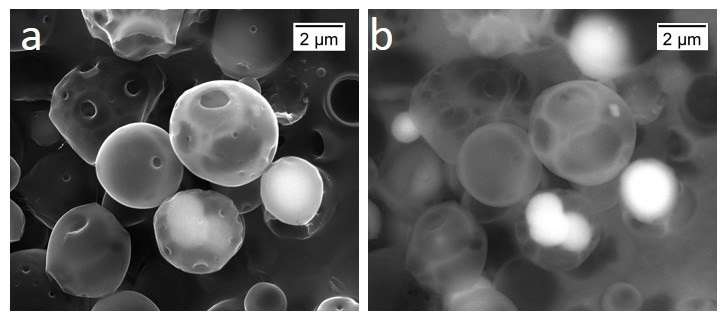SEM images (obtained from the BSE detector) of PLA-coated micro-particles with various mass ratios of CaCO3 particles relative to PLA (a) 0, (b) 0.2. Credit: Tomsk Polytechnic University (TPU)
Researchers from Tomsk Polytechnic University and Queen Mary's University of London have developed smart capsules that deliver water-soluble compounds to a certain part of the body. Two-micron capsules have watertight shells containing nanoscale magnets, delivering a drug to a targeted part of the body. Once delivered to the site, the capsules gradually dissolve, releasing the drug. According to the researchers, such measures will assist in the delivery of drugs that consist of proteins and other water-soluble substances used to treat a wide range of diseases including cancer and infectious diseases. The study results were published in Colloids and Surfaces B: Biointerfaces.
"Some drugs contain components that dissolve rapidly in liquid media. For example, proteins immediately begin to dissolve in water. In recent decades various drug delivery methods have been developed, including polymeric micelles, multi-layer micro-capsules and liposomes. However, when using these technologies fluids leak into the 'package' of our drug. As a result, when it comes into contact with aqueous media in the body, its water-soluble components begin to dissolve and the treatment is not efficient. We were tasked to improve the retention of the loaded cargo inside capsules and prevent the ingress of fluids into them," says Valeriya Kudryavtseva, a graduate student of the Institute of Physics and Technology.
To address this problem, researchers from the Laboratory of New Medications, RASA Center in Tomsk and collaborators sought to create a combined package for drugs consisting of calcium carbonate coated with a thin nano-layer of polylactic acid—a biodegradable polymer that TPU scientists apply in the creation of biodegradable implants.
"Earlier, there were studies with these materials carried out separately. Our colleagues tried to load drugs either into capsules of polylactic acid or into particles of calcium carbonate. Nobody combined the properties of both materials. We decided to experiment and find out what happens as a result," says Valeriya Kudryavtseva.
She says it was a laboratory study. The scientists tried to dissolve the improved capsules, which used a combination of these materials, in various fluids identical to those found in the human body. The capsules were successfully tested. "Thanks to polylactic coating, calcium carbonate did not dissolve under the conditions under which it normally dissolves.
More information: Valeriya L. Kudryavtseva et al. Fabrication of PLA/CaCO 3 hybrid micro-particles as carriers for water-soluble bioactive molecules, Colloids and Surfaces B: Biointerfaces (2017). DOI: 10.1016/j.colsurfb.2017.06.011
Provided by Tomsk Polytechnic University






















